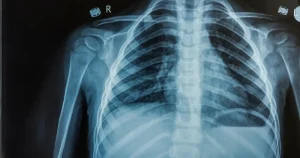
The cervical spine is vital for health. It provides structural support and spinal cord protection. Understanding the connection between spinal health and organ function is vital for anyone seeking optimal wellness.
As a chiropractor with extensive experience treating subluxation, I have seen firsthand how this often-overlooked condition can have far-reaching effects on a person’s overall health. A dislocation is an imbalance or partial movement of the vertebrae within your spine. This may seem like a structural problem, but it can significantly affect your organs and bodywork.
In this post, we’ll explore how subluxation of the spine can affect the health of your organs and what you can do about it.
Understanding Subluxation
- Auto accidents and slips are common causes.
- Lousy posture over time can also lead to misalignment.
- Chronic stress can create muscle tension, which contributes to the problem.
- Repetitive movements can put uneven stress on specific spine areas.
- A sensation of discomfort in the struck region
- Stiffness in the spine or surrounding muscles
- Reduced range of motion
- Weakness or tingling in the limbs.
- Weakness in certain muscle groups
- Altered sensations in different parts of the body
The Spine and the Nervous System
The human backbone comprises 33 bones stacked on top of each other, representing the vertebral column. The discs between the vertebrae join each vertebra and serve as shock absorbers, allowing for mobility and softening impact.
The spinal cord is an integral part of the central nervous system. It passes through the vertebrae, and nerves spread out from it to different parts of the body. Proper spine alignment protects the spinal cord and nerves and allows the nervous system to work correctly.
The nervous system serves as the body’s master control system. It regulates every cell, tissue, organ, and function and allows the mind to interact with other parts of the body.
This system manages all body functions. It handles simple actions like breathing and digestion and complex tasks like movement and thinking. When subluxation occurs, it can disrupt this vital communication network.
Misalignment can disrupt nerve signals, causing various medical concerns, including system failure. Spinal health is essential for the body’s overall function, and subluxation of the spine can significantly impact a person’s health and well-being.
Impact of Subluxation on Organ Health
Due to the nervous system’s interconnected nature, subluxation can affect any organ in the body. Specific areas of the spine correspond to different organs and bodily functions.
1. Arms, Elbows, Hands and Fingers
Subluxation of the T1 vertebra can significantly impact the upper extremities. When this vertebra is misaligned, patients often report pain, numbness, and soreness that radiates from the shoulder down into the arm and hands. This connection demonstrates spinal health is crucial for proper limb function and sensation.
2. Lungs and Bronchial Tubes
Subluxation of the T3 vertebra can impact respiratory function. Patients may experience asthma-like symptoms, difficulty breathing, and chest tightness. In severe cases, this misalignment can lead to bronchitis, pleurisy, pneumonia, congestion, or symptoms similar to the flu. I have seen many patients report improved breathing after we have addressed subluxations in this area.
3. Spinal Cord
Cervical subluxations are especially alarming since they are the most unstable type of cervical spine damage. They can induce a variety of vertebral subluxations relative to adjacent vertebrae, typically due to ligamentous harm and leaping facets. This increases the risk of spinal cord injury, which can have severe consequences.
4. Stomach, Gallbladder, Liver, Pancreas, Spleen, Adrenal Glands, Kidneys, Colon, Uterus
- T4: Gallbladder problems, jaundice, and rashes
- T5: Hepatic issues, such as blood pressure, circulation problems, and arthritis.
- T6: Stomach troubles like indigestion, nervous stomach, heartburn, dyspepsia.
- T7: Ulcers And gastritis.
- T8: Lowered immune resistance
- T9: Allergies, hives.
- T10: Renal problems, artery hardening, relentless fatigue, necrosis, and pyelitis
- T11: Skin problems such as pimples, cystic acne, Eczema, and rashes
- T12: Rheumatic diseases, gas discomfort, and particular forms of sterility
5. Heart, Coronary Arteries, Chest Area
When subluxated, the T2 vertebra can affect the heart, coronary arteries, and chest area. Patients with misalignments here may experience chest pain, tightness, heartburn, and general soreness in these areas. In some cases, functional heart conditions may develop. Addressing these subluxations can help, but a heart doctor should check ongoing heart symptoms.
6. Nerve Roots
Cervical subluxations can interfere with nerve roots, altering communication between the brain and other body parts. This interaction interference could lead the body to fail or perform below par. It’s a prime example of how spinal health affects overall bodily function.
Related, Chiropractic Care for Subluxation
Treatment and Management of Subluxation
As a chiropractor, I employ various techniques to correct subluxation and restore proper spinal function. These include spine procedures to realign vertebrae, soft-tissue treatment to treat muscular stress and inequalities, and correcting posture exercises.
Regular chiropractic adjustments can help restore proper joint alignment and function, reduce nerve interference, and improve overall spinal health and mobility.
These treatments aim to alleviate current symptoms and prevent future issues by maintaining optimal spinal alignment and function.
Along with chiropractic care, I constantly recommend changing your lifestyle to improve spinal health. These changes include improving posture and ergonomics in daily activities, incorporating specific exercises and stretches to strengthen the spine and support muscles, and maintaining a healthy weight to reduce stress on the spine.
These lifestyle modifications complement chiropractic treatments and help maintain the benefits of adjustments over the long term.
Prioritize Spinal Health and Seek Chiropractic Care at My Clinic
Understanding the connection between subluxation and organ health is crucial for overall wellness. Maintaining appropriate spinal alignment not only prevents back discomfort but also benefits the overall health of your body.
My clinic specializes in detecting and correcting subluxations to help you achieve optimal health. Do not wait for symptoms; proactive care is the secret to lasting wellness.
If you have any concerns about your spinal health or are experiencing any signs we have discussed, I encourage you to book a consultation. We can work together to create a tailored strategy that meets your individual needs and assists you in achieving your health goals.
REFERENCES
- Cleveland Clinic. (2023, October 18). Spine: Anatomy, function, parts, segments & disorders. https://my.clevelandclinic.org/health/body/10040-spine-structure-and-function
- Arrowhead Clinic. (n.d.). List of symptoms caused by subluxation of the thoracic spine. Arrowhead Clinic. Retrieved August 26, 2024, from https://www.arrowheadclinic.com/category/blog/thoracic-spine-subluxation-symptoms
- National Center for Biotechnology Information. (n.d.). Cervical subluxation. In Bookshelf. https://www.ncbi.nlm.nih.gov/books/NBK559144/

Meet Dr. Craig Eymann, a dedicated chiropractor and yoga enthusiast with over two decades of expertise in spinal health, sports chiropractic, and personalized care, prioritizing misalignment correction for swift injury resolution.
Categories
Tags
Recent Blogs




Leave A Comment